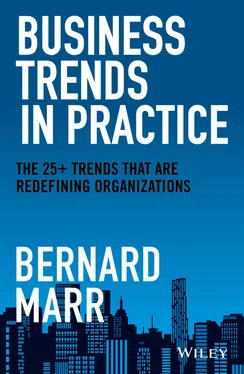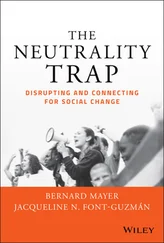Gates's book is a fascinating read and I urge everyone to read it. But while he has brilliant and practical ideas, we can't ignore the fact that solving the climate crisis is a global responsibility, requiring countries to work together and take collective action. The fact that global economic and political power structures are also undergoing huge changes will only make the job harder. This leads us to the next topic.
Trend 2: Shifts in Economic and Political Power
The economic and political world order is changing and, by 2050, the list of the most economically and politically powerful countries in the world will look very different to today.
Take China as an example. Due to the impact of the coronavirus crisis, China's economy is now predicted to overtake the United States by 2028, five years earlier than previously thought. 9 China is one of the so-called E7 emerging countries – alongside India, Brazil, Mexico, Russia, Indonesia, and Turkey – countries whose economies are expected to exceed those of the G7 advanced economies.
Let's look at a few stats that highlight the startling shifts in power that are coming our way: 10
By 2050, the EU27's share of global GDP will be just 9 percent, while China's is expected to be 20 percent.
BY 2050, India will rank second in the global GDP rankings, putting it behind China and ahead of the US. Indonesia will rank fourth. The UK could be down to 10th place.
E7 economies could grow around twice as fast as the G7. In fact, the combined economic power of the E7 economies could be double that of the G7 by 2040 – that's from being the same size as the G7 in 2015 and half the size in 1995.
And then there are the “next 11” emerging economies, including Bangladesh, Egypt, Nigeria, Pakistan, and Vietnam. These economies are projected to overtake the EU27 in global power as early as 2030. 11
Bottom line, the West has been on the rise for centuries, but that is about to change. The E7 and next 11 economies will increasingly hold more sway in the global economy and, in turn, in world politics. Earlier in this chapter, I mentioned that China is building close links with African nations for access to land and rare resources, and this is just one example of China extending its global influence.
This power shift will no doubt bring new tensions, particularly as the world's most precious resources become scarcer. We may also see a new Cold War emerge around technology. China has said it wants to be a world leader in artificial intelligence by 2030, and has introduced measures to control the export of AI technologies by Chinese companies. 12 President Trump's ban on Huawei's products and telecoms equipment gives us another glimpse of how countries may seek to restrict the technological capabilities of other countries. In other words, rather than bringing the world closer together, technology may be yet another thing that exacerbates global tensions and contributes to growing divergence.
Trend 3: Growing Divergence and Polarization
After decades of globalization has brought countries closer together, there are signs that countries (and the alliances and systems they participate in) are beginning to decouple. There have been some notable examples of political fragmentation and growing divergence in recent years. We've seen it in the US, when President Trump withdrew from the Paris Agreement on climate mitigation, announced plans to withdraw America from the World Health Organization, and even spoke about withdrawing from NATO. And we've seen it in the UK, with the country leaving the European Union. In the UK, Brexit really emphasized the way large sections of society have shifted toward extreme sides of arguments, with little or no ability to see the other side's perspective. People fell out with friends, neighbors, and family members because of their political opinions, and American voters experienced the same thing during the 2020 election. Groups are becoming more divided along ideological lines, and that goes for groups of voters, and groups within society (think of the often vitriolic debates around feminism or trans rights). A 2019 survey by the Pew Research Center found that partisan division and animosity have deepened since 2016; 63 percent of Republicans said Democrats were “more unpatriotic” than other Americans, and 55 percent said they were more immoral. Meanwhile, 75 percent of Democrats said Republicans were more close-minded than other Americans, and 47 percent said they were more immoral. 13
In short, the world feels more polarized than ever. I find this both crazy and disturbing. When did society become so polarized that you're either a staunch Democrat or Republican (or a Brexiter or Remainer, or any other position, political or otherwise), with nothing in between? And when did the other side become immoral and less patriotic? Losing all concept of the other side's perspective is, to me, a danger to our democracy and society. Yet that's exactly what's happening.
When information and analytics company IHS Markit set out its prediction of how the world would look in 2025, it said the “fragmented world” scenario is the most likely. In this scenario, the US, China, the EU, and other key players retreat from globalization and turn their focus inwards to concentrate on domestic challenges. 14 It's only a prediction, of course, but the COVID-19 crisis and the resulting economic fallout is likely to exacerbate the desire to turn inwards and focus on domestic problems.
There are a number of reasons why divergence and polarization have grown. There's no global enemy or external threat keeping disparate countries united. And, of course, we can't ignore the impact of social media ghettoes that show people only what they want to see. Thanks to social media algorithms, we simply don't all see the same news. Instead, we're served a stream of content that's personalized to our habits, interests, and beliefs. This is known as the “filter bubble.” Trapped in our bubbles – because this is something we're all susceptible to – we may begin to believe the world is exactly as we see it. Fake news spreads quickly in this environment, because the people in your filter bubble share the same views as you, and it's much easier to believe a fake news story when people you follow are sharing and talking about it. Meanwhile, real problems and issues – and the need to work together to solve society's problems – get lost in the noise.
Technology, then, may play a key role in this growing divergence and polarization. I've already raised the prospect of a technology “Cold War,” and we see hints of this with China restricting companies from exporting technology services, and preventing citizens from accessing certain websites. China is the best-known example of a country with its own isolated internet, and this is something we may see more of in the future. This splintering of the internet even has a name: the “splinternet.” Indeed, Russia has already confirmed that it has created a system that would allow the country to completely decouple from the rest of the world's internet and operate its own independent internet. 15
Another factor that may be fueling polarization and divergence is racial and ethnic diversity. While diversity is a long-term benefit for society, in the short term it can trigger social and political conflict and a breakdown in trust. Which brings us to the next subject.
Trend 4: Shifting Demographics
The global population in 2050, or even 2030, will look very different from today. Depending on where you are in the world, the population is growing and aging. We're seeing greater urbanization and more megacities. And, as I've previously mentioned, climate change may mean hundreds of millions of people are displaced and forced to migrate to other areas.
Читать дальше












